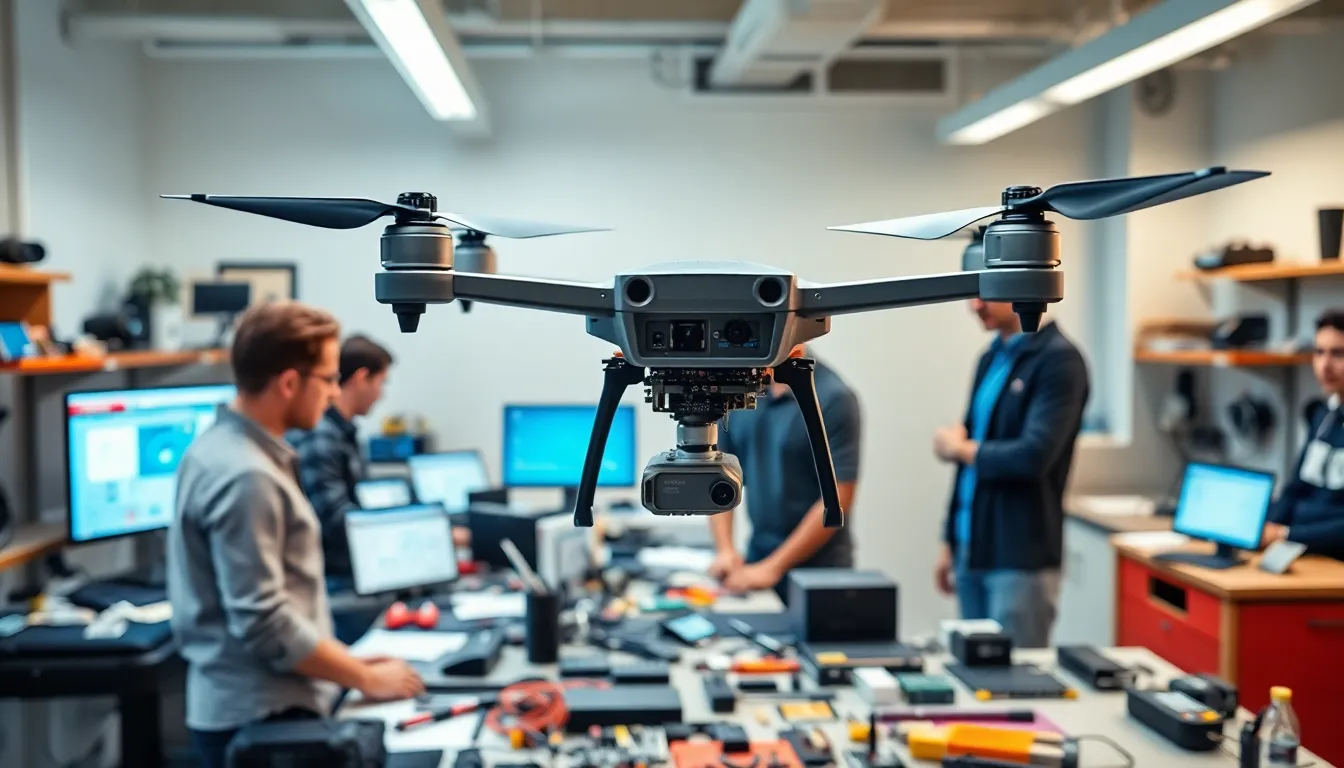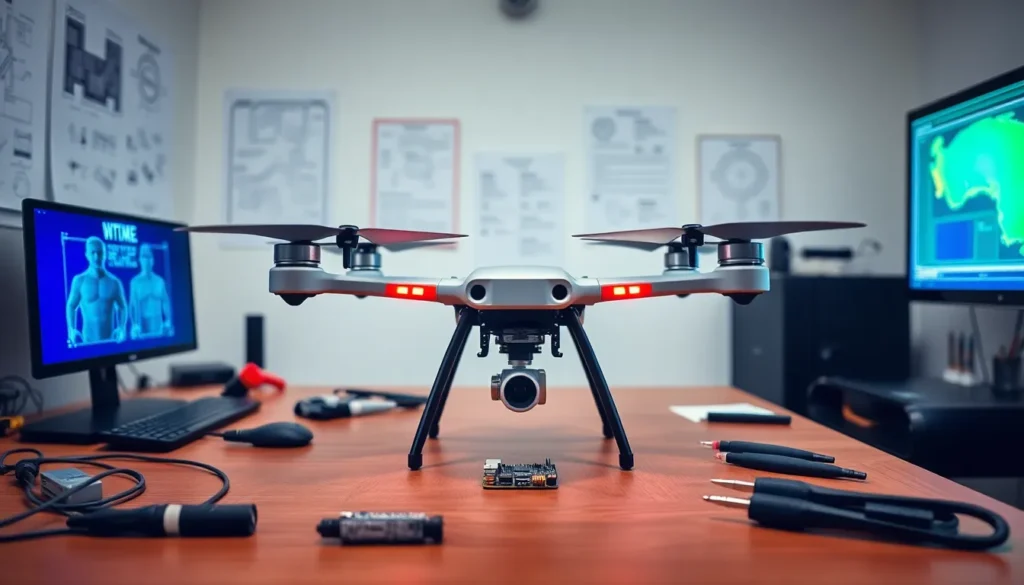Table of Contents
ToggleHave you ever dreamed of building your own tech-savvy drone? Thanks to the Raspberry Pi Zero, that dream isn’t far away. This tiny powerhouse is making waves in drone technology, especially when combined with thermal imaging. Get ready to soar high as we jump into the world of Raspberry Pi Zero drones, where innovation meets practicality. Who knew creating your own thermal drone could be so fun, and a bit nerdy?
Understanding the Raspberry Pi Zero

The Raspberry Pi Zero is a small yet mighty computer that packs a punch even though its compact size. Measuring just about the size of a credit card, it’s a perfect choice for anyone looking to jump into the world of DIY electronics and drones.
Key Features and Specifications
Equipped with a powerful ARM11 processor, the Raspberry Pi Zero can run a variety of operating systems, including Raspbian. It features 512MB of RAM and comes with USB OTG support. Another impressive aspect is its GPIO pins, allowing for the connection of various sensors and components. For drone makers, its lightweight nature and low power consumption are game changers.
Application in Drone Technology
In the realm of drone technology, the Raspberry Pi Zero serves as the brain. Engineers and hobbyists alike use it for flight control, telemetry, and data processing. With the ability to interface with GPS modules and various sensors, the Raspberry Pi Zero can transform a simple quadcopter into an intelligent flying machine.
Benefits of Using Raspberry Pi Zero in Drones
Employing Raspberry Pi Zero in drone construction has several advantages. First, its affordability ensures that building a custom drone doesn’t expensive. The numerous online resources and community support make troubleshooting issues a breeze. Also, its lightweight design means that it won’t add unnecessary bulk to the drone, keeping flight performance intact.
Thermal Imaging for Drones
Thermal imaging technology is revolutionizing various industries, and drones are leading this charge.
How Thermal Cameras Work
Unlike standard cameras that capture visible light, thermal cameras detect infrared radiation. Essentially, they visualize heat, enabling users to see what’s happening in environments that are pitch black to the human eye. This technology is invaluable in mission-critical areas such as search and rescue operations or infrastructure inspection.
Integrating Thermal Cameras with Raspberry Pi Zero
Integrating thermal cameras with the Raspberry Pi Zero is surprisingly straightforward. Several platforms and libraries, like OpenCV, help developers create applications that leverage thermal data. Many available thermal cameras communicate through I2C or GPIO connections, making assembly with the Pi Zero quite manageable. This allows users to process thermal images on the fly, capturing invaluable data during flights.
Applications of Thermal Drones
Thermal drones open up a plethora of applications across various fields, revolutionizing how tasks are accomplished.
Search and Rescue Operations
In search and rescue operations, thermal drones become lifesavers. They can cover large areas quickly, detecting heat signatures of lost individuals or animals in challenging terrain. When every second counts, such advantages make all the difference.
Agricultural Monitoring
Farmers are increasingly turning to thermal drones to monitor crop health. By analyzing thermal images, they can assess plant health, identify irrigation issues, and optimize water usage. This not only boosts yield but also promotes sustainability.
Environmental Surveillance
Thermal drones are also crucial in environmental monitoring. They help track wildlife, assess the health of ecosystems, and even detect illegal activities such as poaching. By providing real-time data, these drones assist conservation efforts in more impactful ways than traditional methods.
Building Your Own Raspberry Pi Zero Thermal Drone
Constructing a Raspberry Pi Zero thermal drone is a rewarding try that anyone passionate about technology can pursue.
Required Hardware and Components
First, gather all necessary components, including a Raspberry Pi Zero, a compatible thermal camera, ESCs (Electronic Speed Controllers), a flight controller, motors, and a battery. Having quality materials ensures performance, so don’t skimp on important parts.
Step-by-Step Assembly Guide
The assembly process begins with installing your Raspberry Pi and configuring it according to the thermal camera’s specifications. Next, attach the motors to the frame, connecting them to the flight controller. This is followed by integrating the thermal camera and ensuring all components communicate correctly. Finally, check that your propellers are securely attached before your test flight.
Programming and Calibration
After assembly, it’s time to program the Raspberry Pi. Use Python or similar languages to write scripts that capture and process thermal images. Calibrating the thermal camera is crucial for accurate readings. Testing various settings will allow you to optimize performance during flights.
Challenges and Considerations
While building and operating a Raspberry Pi Zero thermal drone is thrilling, it comes with its own set of challenges.
Battery Life and Power Management
One significant concern is battery life. Thermal cameras can be power-hungry, so using an efficient power management system is vital. Consider investing in high-capacity batteries or explore ways to optimize energy consumption through smart coding practices.
Weight Considerations and Payload Capacity
The weight of the components matters more than one might think. Adding a thermal camera will inevitably affect the drone’s flight dynamics. Careful calculations should guide the selection of components to keep the drone within a manageable weight for high performance.
Future Trends in Thermal Drones
The world of thermal drones is continuously evolving, and future trends promise even more fascinating advancements.
Advancements in Technology
Emerging technologies are improving thermal camera sensitivity, allowing for lower-cost cameras that produce clearer images. Enhanced algorithms are making it easier to analyze thermal data quickly, expanding the potential applications of thermal drones.
Potential Applications and Innovations
Looking ahead, the integration of AI with thermal drone technology could lead to breakthroughs in automated surveillance and immediate threat detection. Besides, as technology becomes more accessible, we can expect to see innovations across fields like construction, wildlife conservation, and energy management.





